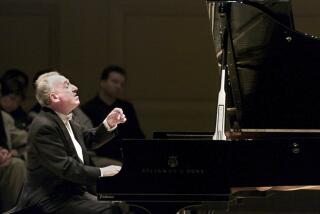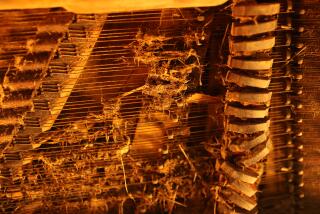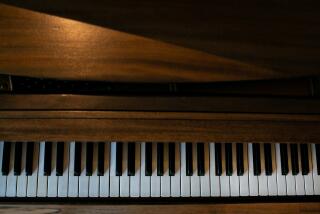Speak, Memory
“Piano Roles: Three Hun- dred Years of Life with the Piano” is an ambitious attempt to chronicle the role the piano has played in our lives from its invention around 1700 in Florence to the modern concert grand, which is equally at home in both the classical and jazz repertoire. This elegant book is for those who struggle to master the instrument as well as for those who simply prefer to succumb to its beauty.
On nearly every one of its 462 pages are photographs as well as reproductions of artwork, advertisements and music pertaining to the piano. You’ll find an advertisement published in 1845 for the then not unlikely combination of a music and umbrella store, the 1866 application to patent a piano that converts into a bed (with no indication that this not unlikely combination was ever manufactured) and a charming print dating from 1888 of Japanese dignitaries in formal Western attire dancing, under flowering trees, to the strains of a piano.
The text encompasses both an exhaustive history of the development of the piano, qua instrument, and a far-reaching (and sometimes far-fetched) meditation on both how the piano has affected social history and how society has determined the instrument’s development.
The piano, that nearly ubiquitous symbol of middle-class aspirations, is, second only perhaps to the bed, the most symbolic piece of furniture in the home. It is not only noisy with music but, even when it lays silent, it sings of our dreams and disappointments. Though often relegated to serving as a large counter on which to place well-framed family photos, it has come to symbolize the middle-class security of well-behaved children and material comfort. When you are a child, its presence can make you feel guilty that you haven’t practiced more or angry that you are expected to; when you are a teenager, its keys can beg you to caress them or repel you with the realization that you will never be able to draw from its body the beauty of which you dream; and when you are an adult, the piano can recall the comforts of a stable home or sadden you with their passing. D.H. Lawrence evokes this nostalgia in his poem “Piano”:
Softly, in the dusk, a woman is singing to me; Taking me back down the vista of years, till I see A child sitting under the piano, in the boom of the tingling strings And pressing the small, poised feet of a mother who smiles as she sings.
Will a couch or rug ever resonate as much?
“Piano Roles” contains nine chapters by more than a dozen writers, with a foreword by Noah Adams, the National Public Radio commentator and author of “Piano Lessons: Music, Love, & True Adventures”; and an introduction and afterword by James Parakilas, who helped organize the “Piano 300” exhibition at the Smithsonian Institution. Yet the most meaningful section of the book was not written for this collection but was excerpted from poet Marina Tsvetaeva’s remarkable 1934 essay, “Mother and Music.” In the sections titled “The Metronome” and “The Piano Stool,” Tsvetaeva brings these inanimate objects alive like Copelius’ doll or the furniture in Ravel’s “L’enfant et les sortilege,” to torment and cajole their young victim. She describes the mysterious act of touching the piano’s keys: “And for pressing itself: for the possibility, at the merest touch, of beginning to drown right away, to drown without end. . . .”Then the black and white keys become a rebus: “And because it is mourning: mother’s, in the black-and-white stripes of the summer’s-end blouse when after the telegram: ‘Grandfather passed on in peace’--she herself appeared, tearstained but still smiling, with the first words for me: ‘Musia, your grandfather loved you a great deal.’ ” Alongside the memoirs of the Nobel Prize-winning author Elias Canetti, who finds his love for reading inextricably tied up with his love for his father, stands the monument of Tsvetaeva’s essay, in which her mother tormented her with music. Yet after she lost her mother, the torment remained as a consolation.
Unlike the harpsichord or the pianoforte, the piano was conceived as a solo instrument with a varied tonal palette, capable of making crescendi and decrescendi like an orchestra. First heard in a public concert in the 1760s, the piano paralleled economic progress in its development: The first century of concerts were for the aristocracy and the elite, but by the time Steinway patented cross-stringing in 1859 and the piano’s sound could fill a large concert hall, concerts were accessible to the general paying public. In fact, by the mid-19th century, the industrial production of the piano made it easily accessible for ownership by the middle class. Piano playing became so popular that Charles Dickens noted on a visit to the United States in 1842 that it was common for working girls to play beautifully on their boarding house pianos. English soldiers and businessmen took pianos to India in 1790, a German physician took a piano to Japan in 1820, and Capt. Robert Falcon Scott even brought a player piano to the Antarctic in 1910. (Incidentally, the title of the book, “Piano Roles,” is a play on the name of player piano’s music: a piano roll. Though now a curio, the player piano played the important role through World War I of taking music to cities that had never heard a live performance and to homes.
The piano became so popular because, though the violin might be the king of the orchestra, the piano is the orchestra. It can thunder or whisper, singing like a diva and weeping like a cello. When accompanying a violin, a school musical or a ballet class, it “supplies whatever they need to make their illusion complete,” as Parakilas writes. In fact, George Bernard Shaw, in his “The Religion of the Pianoforte,” declared it “ . . . the most important of all musical instruments: its invention was to music what the invention of printing was to poetry.” To open the front door and see the piano in the living room is to come home. In such a home can live in harmony the demons from Dr. Seuss’ 1952 phantasmagoria, “The 5000 Fingers of Doctor T” about the boy who didn’t like to practice; the disappointment of Tsvetaeva’s mother that both her daughter and her husband could not understand her love of the piano (though he secretly cherished a tune from “Aida” which Tsvetaeva describes as “a keepsake from his first wife, a song bird who had early been silenced”); and with D. H. Lawrence’s little boy, happily playing under the piano, knowing his mother would live forever.
More to Read
The biggest entertainment stories
Get our big stories about Hollywood, film, television, music, arts, culture and more right in your inbox as soon as they publish.
You may occasionally receive promotional content from the Los Angeles Times.










